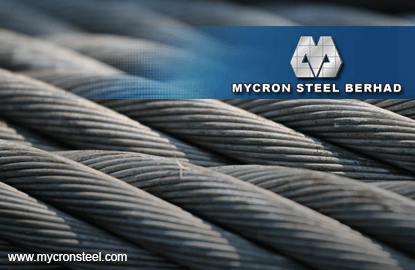
SINCE early this month, Mycron Steel Bhd’s share price has more than doubled, closing at 92 sen last Thursday.
While many steel counters saw similar, albeit not that strong, gains, the positive sentiment surrounding Mycron seems to have been due to its sterling set of financial results released last month.
To recap, for its financial year ended June 2016 (FY2016), Mycron posted a net profit of RM24.18 million from RM566.81 million in sales. Compared with FY2015, net profit was up 107% despite a mere 9.35% increase in revenue. Earnings per share for FY2016 was 8.56 sen, which indicates that Mycron at its close last Thursday was trading at 10.8 times price multiples of its earnings.
It is also noteworthy that at 92 sen, Mycron is still trading below its net asset per share of RM1.19 as at June 30.
While Mycron seems to have done well financially, there could be other obstacles.
Speaking to steel industry executives, it is worth noting that if not for an impairment loss or write-down of property, plant and equipment of RM8.65 million in FY2016, Mycron would have posted its highest profit since 2002, which is an achievement considering the bleak economic environment.
Mycron is involved in the production of cold rolled coils, the raw material of which is hot rolled coils (HRC). This is classified as flat steel, which is used to make almost everything, including electrical items and cars, as opposed to long steel, which is used in the construction industry.
It should also noted that Mycron’s gross profit at RM78.27 million is commendable, considering the damp economic climate.
And judging by Mycron’s announcements to Bursa Malaysia, the upturn in earnings may not be just a flash in the pan.
In the notes accompanying its financials, Mycron says, “In summary, the group’s outlook for the next financial year (FY2017, the current financial year) is cautiously optimistic on the assumption of a more level competitive landscape in a generally captive market despite a subdued economic outlook.
“Barring any severe external shocks, the group is hopeful to continue delivering positive results for the next financial period.”
It is worth noting that Mycron also had retained earnings of RM107.51 million as at end-June this year.
The company’s cash balances amounted to RM27.63 million while its short-term debt commitments stood at RM84.34 million and long-term borrowings at RM7.24 million. Shareholders’ funds were at RM335.44 million.
In its results announcement to Bursa Malaysia, Mycron says its gearing as at end-June was a mere 0.6 times.
The many issues plaguing steel companies
But many analysts remain cautious on the sector due to factors ranging from the unfavourable economic conditions to global overcapacity and influx of cheap imports.
Megasteel Sdn Bhd, a unit of the Lion Group, has the monopoly to supply HRC in the country, but the company has been closed for a few months now.
Megasteel, which is 79%-owned by Lion Corp Bhd and 21% by Lion Diversified Holdings Bhd, has been bleeding and had requested the government to put safeguards in place for imports of HRC, failing which it ceased operations.
In FY2015, Megasteel suffered an after-tax loss of RM615.92 million on revenue of RM1.91 billion. As at end-June, it had accumulated a loss of RM2.14 billion.
It is not clear if the government will relook the safeguards issue, but industry sources highlight that 2017 could be an election year and anything is possible, considering Tan Sri William Cheng Heng Jem, the controlling shareholder of the Lion Group, is very well connected.
Another potential HRC producer, Southern Steel Bhd, which is 71.42%-controlled by billionaire Tan Sri Quek Leng Chan, has commenced arbitration proceedings against Danieli & C Officine Meccaniche SpA and Danieli Malaysia Sdn Bhd after terminating a contract for the design, manufacture and supply of a thin slab casting unit for the production of HRC.
This lack of local HRC seems to have worked out well for Mycron.
In its financial results announcement, Mycron says, “For the next financial year, the group will be able to aggregate its raw material procurement of HRC requirements from best sources abroad (in price and quality) unlike in the past where its steel tube operation was constrained by regulations to procure from domestic producers of lower quality scrap-based HRC materials at higher prices.”
Nevertheless, there are fears that the government will open the floodgates and remove all restrictions on imports, allowing all, including steel traders, to bring in HRC, which could then kill the market.
“There is this tendency to open the floodgates … which could be bad. The government should gradually open the market, after engaging with the [steel] industry. It has to be certain what is locally produced and what is not,” an industry observer says.
Nevertheless, other issues emerge with the paying of import duties, such as a lack of banking support.
While there is little price difference between the imported and local HRC, there is great difficulty in seeking financing, with banks unwilling to support the steel industry after the Megasteel and Perwaja Steel Bhd debacles.
For instance, Mycron’s finance cost for FY2016 was RM11.41 million for total borrowings of RM91.58 million, which seems high. An industry source says steel companies pay higher interest rates, in the region of 6% to 7%, compared with other industries, which are pegged at below 5%.
“It’s due to legacy issues, Megasteel and Perwaja … banks don’t really understand the nature of our industry. Now, steel companies are working with banks to pay off their borrowings,” the industry observer says.
Considering all this, Mycron is likely to find itself in the cross hairs of investors over the near term.
Save by subscribing to us for your print and/or digital copy.
P/S: The Edge is also available on Apple's AppStore and Androids' Google Play.